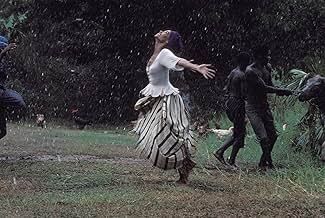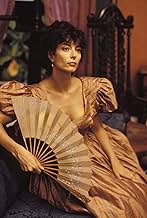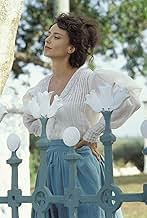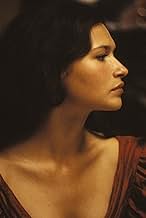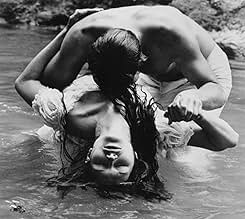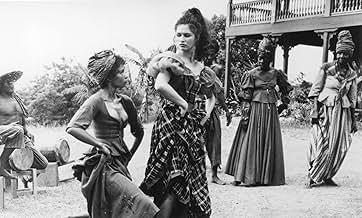PUNTUACIÓN EN IMDb
5,6/10
2,3 mil
TU PUNTUACIÓN
Añade un argumento en tu idiomaIn 1840s Jamaica, a young female landowner marries an Englishman to keep her property. Their love blossoms, but she hides a childhood secret about her mother that threatens their relationshi... Leer todoIn 1840s Jamaica, a young female landowner marries an Englishman to keep her property. Their love blossoms, but she hides a childhood secret about her mother that threatens their relationship.In 1840s Jamaica, a young female landowner marries an Englishman to keep her property. Their love blossoms, but she hides a childhood secret about her mother that threatens their relationship.
- Dirección
- Guión
- Reparto principal
Martine Beswick
- Aunt Cora
- (as Martine Beswicke)
Reseñas destacadas
Based on Jean Rhys' 1966 novel, "Wide Sargasso Sea" is the story of Antoinette Cosway, who shows up in Charlotte Bronte's classic 1847 novel "Jane Eyre" as Rochester's first wife Bertha Mason - confused? Rhys has taken some liberties with timelines, and some names and relationships have been changed for no apparent reason. Quibbles aside, this movie stands on its own. Gorgeous Jamaican scenery, lush erotic scenes (I think I saw the uncut version) that perfectly convey Rochester and Antoinette's passion, but a sense of foreboding (for those familiar with the Bronte book, anyway). The ending is a bit abrupt, and seems rushed after the leisurely pace of the rest of the film.
Having just read Rhys' novel, I was delighted at how much of its dialogue and narrative was so faithfully adapted, and praise the screenwriters for making sense out of a rather confusing book - it jumps around in time, and is narrated by Antoinette and Rochester in turn. The movie makes the story much more clear. Excellent performances from KARINA LOMBARD(is that her real accent?) as Antoinette, NATHANIEL PARKER as Rochester, and CLAUDIA ROBINSON as Christophine (a much more sympathetic character than she appears in the book). Was also impressed with the cameos from MICHAEL YORK, RACHEL WARD and MARTINE BESWICKE.
Having just read Rhys' novel, I was delighted at how much of its dialogue and narrative was so faithfully adapted, and praise the screenwriters for making sense out of a rather confusing book - it jumps around in time, and is narrated by Antoinette and Rochester in turn. The movie makes the story much more clear. Excellent performances from KARINA LOMBARD(is that her real accent?) as Antoinette, NATHANIEL PARKER as Rochester, and CLAUDIA ROBINSON as Christophine (a much more sympathetic character than she appears in the book). Was also impressed with the cameos from MICHAEL YORK, RACHEL WARD and MARTINE BESWICKE.
Jean Rhys has taken seven years to finish the novel, on which the movie is supposed to be based on. However, this rated film seems to be only concentrating on the sexual relationship between Rochester and Antoinette, as well as Sandi and Antoinette. The relationship with Sandi is deliberately kept as question marks for readers to ponder upon in the novel, but here in the movie it is explicitly interpreted and the sympathy created by Rhys is lost. But the movie is nevertheless a representation of colors in the Caribbeans--red, purple, blue and green--the exotic side of life that has repeled Rochester.
Sumptuous-looking, beautifully photographed, meticulously produced....this movie seems to do everything right visually. But its story, very engaging in the first half, runs out of steam in the second. Story points and character motivations are often muddled, and I never got a complete and clear idea of where and when exactly the passionate love affair between the two basic characters started to go wrong. And yes, it is sometimes erotic (mostly thanks to the very beautiful Karina Lombard), but it never becomes as steamy as you may have heard. (**1/2)
The following review is taken from my contribution to a thread called "Worst novel adaptations" from the Film General board: Wide Sargasso Sea was originally a beautiful, haunting novel set in mid-19th century Jamaica written by Creole-Welsh writer Jean Rhys in the 1960s. Plot-wise, it's basically the prequel to Charlotte Bronte's Jane Eyre, the story of a young Mr Rochester traveling to the Caribbean and meeting his first wife, the "mad wife" in the attic featured in Jane Eyre (though here she is young and not yet "mad", and we are described what gradually led her to losing her sanity). It's a sensual novel, mainly because the lush Jamaican countryside and emotional spontaneity of the local people was too much for the straight-laced, English Victorian gent, Rochester. But there are no sex scenes in the novel - basically, it's NOT an erotic novel as the film "adaptation" would suggest. It's written in subtle, understated yet powerfully-evoked prose that speaks of the movements of the soul rather than those of the pelvis. There's lots of passion in Wide Sargasso Sea THE BOOK, but it's mostly emotional. It's an extremely multi-layered novel and the work of a true master. The film on the other hand is just your classic, bad 1990s film, beautiful to look at, with lots of skin, languid copulation, heaving bosoms, bodice-ripping nonsense, etc and next to no substance. It has no artistic integrity whatsoever, as its shameless makers must surely know they lifted their middle finger at the spirit of the Jean Rhys novel when choosing to make the film the way they did. None of the understanding of the deepest secrets of the soul that the novel can so miraculously evoke. None of the beauty, poetry, deep, heart-felt tragedy, pathos, haunting quality. Nothing. Just a lot of pointless, choreographed sex between beautiful people in an "exotic" setting. Why not make an erotic version of Jane Eyre while we're at it? Plus there's nothing worse than eroticism that takes itself too seriously. I'd highly recommend the novel by the way: a book you don't forget in a hurry. Needless to say I think you should give this insulting (to the memory of Jean Rhys) film a miss, especially if you've read the novel: it'll just frustrate you, no matter how keen on a bit of easy titillation you may be feeling at the time.
I think that there seem to be some confusion expressed in a number of the reviews of this and a subsequent version of Jean Rhys' most famous novel. Just for information:
1. Creole does not necessarily imply mixed race. Bertha (to use Rochester's name for her) was clearly white enough to appear white and indeed, like Jean Rhys herself, may have been entirely of European ancestry. The mixed race brother, Daniel, was black on his mother's side which has nothing to do with Bertha's mother being mostly/entirely French. He was angry and destructive because his father preferred the white daughter to him.
2. The Wide Sargosso Sea is a sort of prequel but it is also a re-imagining of the back story for Jane Eyre that is intended to take Bertha's character and expand on it with Rhys inability to ever fully reconcile herself to the differences between her origins and life in Europe.
3. While we think of the Caribbean as a dominantly black environment, the origins were Carib Indian and whites colonized the area before the introduction of African slaves. The racial undertone is a more modern view than Bronte likely had. She was trying to deal with the whole idea of foreignness/strangeness and the ultimate solution to the plight of Jane's situation, poor but of "gentle" birth.
4. Of the two filmed versions, the first makes the characters too physically attractive and really misses the novel's stress on the protagonists never meshing rather than loving and losing love.
5. One problem with the casting of Rochester in the first version is that the actor portraying Rochester is distractingly gorgeous and not sufficiently British (apart from his accent). In fact he looks like he rather fits in, in contrast to Bertha's uncle and the other European planters. Of course, the actress who portrays Bertha, even at the end, is so enticing that Rochester's loss of interest is inexplicable.
6. The first film seems to run out of time and rushes the end. Not enough is made of Rochester's anger at being manipulated, whether by voodoo, drugs or circumstances. Once he becomes his father's heir, the return to England should have led to something other than the conclusion. There is definitely insufficient deterioration in Bertha. Their stories are mirror images. He deteriorates and is miserable where she is able to live and she deteriorates where he is able to live.
7. The novels (both Jane Eyre and The Wide Sargosso Sea) have a great deal of narration which is lost in the earlier film and perhaps insufficient in the second. None of the films are substitutes for the books but all are interesting reimaginings.
8. In order to appreciate the Rhys novel, one should read about the author. The same is true of Jane Eyre and its author. The more things change, the more they stay the same.
Finally, while not great, the films both aspire to be literary, which means a lot in an age when filmmakers think there is a need for horror/splatter movies and lots of people apparently agree so I for one say thank you for both versions of the Wide Sargosso Sea and all of the versions of Jane Eyre that offer relief from the current tripe.
1. Creole does not necessarily imply mixed race. Bertha (to use Rochester's name for her) was clearly white enough to appear white and indeed, like Jean Rhys herself, may have been entirely of European ancestry. The mixed race brother, Daniel, was black on his mother's side which has nothing to do with Bertha's mother being mostly/entirely French. He was angry and destructive because his father preferred the white daughter to him.
2. The Wide Sargosso Sea is a sort of prequel but it is also a re-imagining of the back story for Jane Eyre that is intended to take Bertha's character and expand on it with Rhys inability to ever fully reconcile herself to the differences between her origins and life in Europe.
3. While we think of the Caribbean as a dominantly black environment, the origins were Carib Indian and whites colonized the area before the introduction of African slaves. The racial undertone is a more modern view than Bronte likely had. She was trying to deal with the whole idea of foreignness/strangeness and the ultimate solution to the plight of Jane's situation, poor but of "gentle" birth.
4. Of the two filmed versions, the first makes the characters too physically attractive and really misses the novel's stress on the protagonists never meshing rather than loving and losing love.
5. One problem with the casting of Rochester in the first version is that the actor portraying Rochester is distractingly gorgeous and not sufficiently British (apart from his accent). In fact he looks like he rather fits in, in contrast to Bertha's uncle and the other European planters. Of course, the actress who portrays Bertha, even at the end, is so enticing that Rochester's loss of interest is inexplicable.
6. The first film seems to run out of time and rushes the end. Not enough is made of Rochester's anger at being manipulated, whether by voodoo, drugs or circumstances. Once he becomes his father's heir, the return to England should have led to something other than the conclusion. There is definitely insufficient deterioration in Bertha. Their stories are mirror images. He deteriorates and is miserable where she is able to live and she deteriorates where he is able to live.
7. The novels (both Jane Eyre and The Wide Sargosso Sea) have a great deal of narration which is lost in the earlier film and perhaps insufficient in the second. None of the films are substitutes for the books but all are interesting reimaginings.
8. In order to appreciate the Rhys novel, one should read about the author. The same is true of Jane Eyre and its author. The more things change, the more they stay the same.
Finally, while not great, the films both aspire to be literary, which means a lot in an age when filmmakers think there is a need for horror/splatter movies and lots of people apparently agree so I for one say thank you for both versions of the Wide Sargosso Sea and all of the versions of Jane Eyre that offer relief from the current tripe.
¿Sabías que...?
- CuriosidadesThe picture was classified and rated with a restricted NC-17 rating in the USA due to its explicit sexual content. Distributor Fine Line Features decided not to appeal the decision in order to try and gain a lower classification rating to make the movie marketable and able for younger audiences to attend. The New York Times reported "Fine Line Features, the art-film division of New Line Cinema, has accepted the rating for 'El gran mar de los Sargazos (1993)' which includes male frontal nudity".
- Citas
Edward Rochester: England seems far away.
- Versiones alternativasEdited, R-rated version available on video.
Selecciones populares
Inicia sesión para calificar y añadir a tu lista para recibir recomendaciones personalizadas
- How long is Wide Sargasso Sea?Con tecnología de Alexa
Detalles
- Fecha de lanzamiento
- País de origen
- Idioma
- Títulos en diferentes países
- Wide Sargasso Sea
- Localizaciones del rodaje
- Empresas productoras
- Ver más compañías en los créditos en IMDbPro
Taquilla
- Presupuesto
- 4.500.000 US$ (estimación)
- Recaudación en Estados Unidos y Canadá
- 1.614.784 US$
- Fin de semana de estreno en EE. UU. y Canadá
- 33.806 US$
- 18 abr 1993
- Recaudación en todo el mundo
- 1.614.784 US$
- Duración1 hora 40 minutos
- Color
- Relación de aspecto
- 1.85 : 1
Contribuir a esta página
Sugerir un cambio o añadir el contenido que falta

Principal laguna de datos
What is the Spanish language plot outline for El gran mar de los Sargazos (1993)?
Responde

